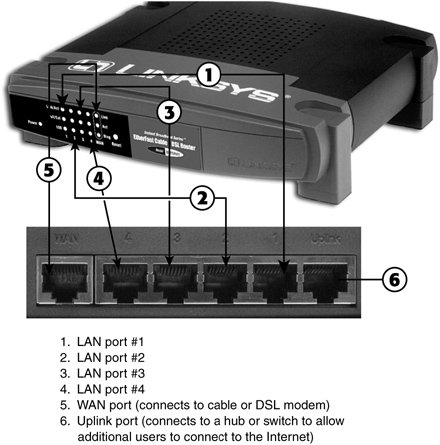Sharing Your Internet Connection
| Whether you have a 56Kbps dialup modem or a broadband connection, one connection is often not enough for a home or small-office setting. You can share your connection with other computer users with one of the following methods:
Typical computer-based sharing solutions include
Both ICS and third-party programs can also work with non-Windows computers because the TCP/IP network protocol, the standard protocol of the Internet, is used for networking.
Router-based solutions are available for popular types of home and small-office networks, including:
Comparing Gateways, Proxy Servers, and RoutersTo the typical user, it doesn't matter whether a gateway, proxy server, or router is used to provide shared Internet access. Traditional gateway programs such as Microsoft ICS, Sygate Home Network, and WinGate use a method of shared access called Network Address Translation (NAT), which enables sharing by converting network addresses into Internet-compatible addresses during the file request and download process. This process requires little client PC configuration but doesn't permit page caching, content filtration, firewalls, or other useful services that can be provided by a proxy server. Proxy servers traditionally have required tricky configurationsometimes at an individual application level. However, products such as WinProxy combine the ease of configuration of a gateway with the extra features of a proxy server. Popular third-party sharing programs include WinProxy (www.winproxy.com), WinGate (www.wingate.com), and SyGate (www.sygate.com). Many home-oriented networks and modems are bundled with these or similar products, so if you're in the market for a new modem or are building a small network, ask whether a proxy server or gateway program for Internet sharing is included. If not, you can download free trial versions from the previously listed websites. If you don't like leaving a computer on at all times to provide Internet access to the network, a router is the only way to go. Routers also provide better firewall protection for all computers on the network, and some, such as certain Linksys models, can be configured to require networked PCs to be running specified firewall or antivirus software before Internet access is granted. The most common routers for broadband Internet access also contain a switch, so you won't need a separate connection device for your home network. Routers for Internet SharingJust as an ICS gateway has two IP addressesone for the network and one for the Internetso does a router. Most routers are sold for use with two-way broadband Internet access devices such as two-way cable modems and fixed wireless broadband services or DSL lines. Most of these devices connect to the computer via a 10BASE-T Ethernet port, as seen in Figure 17.9. Figure 17.9. Front (top) and rear (bottom) views of a typical broadband router with a built-in four-port switch, the Linksys EtherFast Cable/DSL Router, BEFSR41. Top photo courtesy Linksys. When you use a router to share your Internet connection, the WAN port on the router replaces the network card connection originally used to connect your computer with the cable modem or DSL modem. All computers on the network connect to LAN ports and can share files and printers with each other as well as share Internet access. The router can be configured to provide either dynamically assigned or fixed IP addresses to each computer connected to it through the LAN ports and can be configured to use the same MAC address (a unique hardware address assigned to each network component) originally used by the network card first connected to the cable modem or DSL modem. This prevents the ISP from determining that you're sharing the connection. The WAN port on the router can be configured to obtain an IP address from the cable modem or DSL modem or to have a fixed IP address, depending on the configuration required by the ISP. As long as the router is running and properly connected to the cable modem or DSL modem, any computer connected to it can go online just by opening its email client or web browser. Figure 17.10 shows a typical Ethernet home network configuration that uses a router with a built-in switch to share a cable modem. Figure 17.10. When you use a router to share a cable modem or DSL modem, you need only one network card in each computer. This router incorporates a switch that can connect up to four computers to the cable modem. If you have a wireless network, connect the wireless access point or gateway device designed for your network to the cable modem or other broadband Internet device (some also work with dialup modems). The wireless access point or gateway device will transfer data to and from computers on the wireless network and the Internet. For more information about choosing and installing wired and wireless networks, see Chapter 18. |
EAN: 2147483647
Pages: 283

